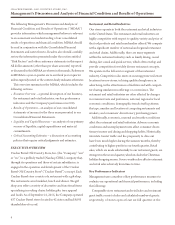Cracker Barrel 2015 Annual Report Download - page 20
Download and view the complete annual report
Please find page 20 of the 2015 Cracker Barrel annual report below. You can navigate through the pages in the report by either clicking on the pages listed below, or by using the keyword search tool below to find specific information within the annual report.
RECENTACCOUNTING PRONOUNCEMENTS
NOTYET ADOPTED
SeeNote 2 to the accompanying Consolidated Financial
Statementsfor a discussion of recent accounting guidance
not yet adopted.e Companyeither expects that the
accounting guidance willnot have a signicant impact on the
Company’sconsolidated nancial position or results of
operations or is currently evaluating the impact of adopting
the accounting guidance.
CRITICAL ACCOUNTING ESTIMATES
We prepare our Consolidated FinancialStatements in
conformity with GAAP. e preparation of these nancial
statementsrequires us to make estimates andassumptions
about future events and apply judgmentsthat aectthe
reported amounts of assets, liabilities, revenue, expenses and
related disclosures.We base our estimates andjudgmentson
historical experience, current trends, outside advice from
parties believed to be expertsin such maersand on various
other assumptions that are believed to be reasonable under the
circumstances, the results of which form the basis for making
judgmentsabout the carrying value of assetsand liabilities that
arenot readily apparent from other sources.However, because
future events and their eects cannot be determined with
certainty, actual results could dier from those assumptions and
estimates, and such dierencescould be material.
Our signicant accounting policies are discussedin Note 2
to the Consolidated FinancialStatements. Judgmentsand
uncertainties aecting the application of those policies may
result in materially dierent amounts being reported under
dierent conditions or using dierent assumptions. Critical
accounting estimates arethose that:
•management believes aremost important to the accurate
portrayal of both our nancial condition and operating
results; and
•require management’s most dicult, subjective or complex
judgments, oen as a result of the need to make estimates
about the eectof maersthat are inherently uncertain.
We consider the following accounting estimatesto be most
critical in understanding the judgmentsthat are involved in
preparing our Consolidated FinancialStatements:
•Impairment of Long-Lived Assetsand Provision for
Asset Dispositions
•Insurance Reserves
•Retail Inventory Valuation
•Ta xProvision
•Share-Based Compensation
•Legal Proceedings
Management has reviewed these critical accounting
estimatesand relateddisclosures with the Audit Commiee
of our Boardof Directors.
Impairment of Long-Lived Assets and
Provision for Asset Dispositions
We assess the impairment of long-lived assets whenever events
or changes in circumstancesindicate that the carrying value
of an asset maynot be recoverable. Recoverability of assets is
measured by comparing the carrying value of the asset to
the undiscounted future cash owsexpected to be generated
by the asset. If the total expected future cash owsare less than
the carrying amount of the asset,the carrying value is wrien
down, for an asset to be held and used,to the estimated fair
value or, for an asset to be disposed of, to the fair value, net of
estimatedcosts of disposal. Any lossresulting from
impairment is recognized by a chargeto income. Judgments
andestimates that we make relatedto the expected useful lives
of long-lived assets and future cash owsare aected by factors
such as changes in economic conditions and changes in
operating performance. e accuracyof such provisions can
vary materially from original estimates and management
regularly monitors the adequacy of the provisions untilnal
disposition occurs.
We have not made any materialchanges in our methodol-
ogyfor assessing impairmentsduring the past three years
andwe do not believe that there is a reasonablelikelihood that
there will be a materialchangein the estimates or assump-
tions used by us to assess impairment of long-lived assets.
18
























